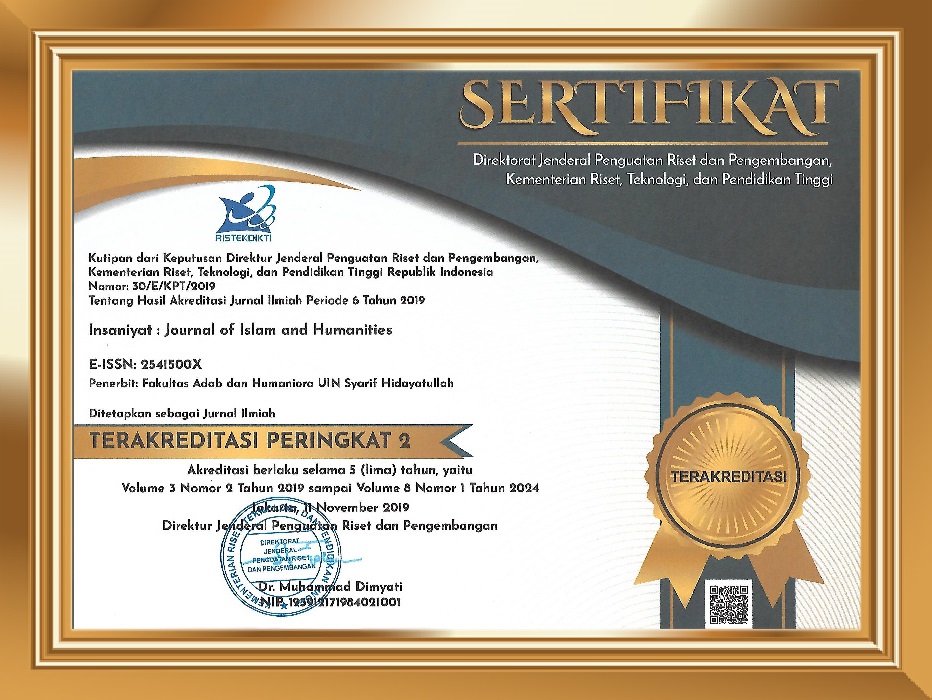Pekojan: Image of an Arab Kampong during XVIII to XIX Centuries Batavia
Abstract
Keywords
References
Anonim. (1900, June 16). Terug naar het kwartier. De Locomotief, p. 2.
Anonim. (1887, June 15). Kolonien. De Tijd, p. 3.
Anonim. (1900, August 30). Land- en Mijnbouw. Het News van den dag voor Nederlandsch-Indie, p. 2.
Brakel, L. F. (1975). Een joodse bezoeker aan Batavia in de zestiger jaren van de vorige eeuw. Studia Rosenthaliana, 63-89.
Chambert-Loir, H., & Dumarçay, J. (1985). Le Langgar Tinggi de Pekojan, Jakarta. Archipel, 30(1), 47-56.
Dick, H. W. (1975). Prahu Shipping in Eastern Indonesia. Part I. Bulletin of Indonesian Economic Studies, 11(2), 69-107.
ffs. (1907). Arabie en Oost-Indie. EJ Brill, 1907.
Hurgronje, C. Snouck. (1994). Kumpulan Karangan Snouck Hurgronje (Vol. IX). INIS.
Kehoe, M. L. (2015). Dutch Batavia: Exposing the hierarchy of the Dutch colonial city. Journal of Historians of Netherlandish Art, 7(1).
Kaptein, N. (1998). The Sayyid and The Queen: Sayyid ‘Uthman on Queen Wilhelmina’s Inauguration on the Throne of the Netherlands in 1898. Journal of Islamic Studies, 9(2), 158-177.
Laffan, M. F. (2002). A watchful eye: The Meccan plot of 1881 and changing Dutch perceptions of Islam in Indonesia. Archipel, 63, 86.
Matusky, P. (1985). An introduction to the major instruments and forms of traditional Malay music. Asian music, 16(2), 121-182.
Mobini-Kesheh, Natalie. (1999). The Hadrami Awakening; Community and Identity in The Netherlands East Indies, 1900 – 1942. Cornell University Publications.
Pijper, G. F. (1934), Fragmenta Islamica: Studien over Het Islamisme in Nederlandsch-Indie. EJ Brill.
Shahab, Alwi. (2004). Saudagar Baghdad dari Betawi. Republika.
Suprihatin, A., Antariksa, A., & Meidiana, C. (2012). Pelestarian Lingkungan dan Bangunan Kuno di Kawasan Pekojan Jakarta. Jurnal Tata Kota dan Daerah, 1(1), 1-12.
Thurlkill, M. (2016). Sacred Scents in Early Christianity and Islam. Rowman & Littlefield.
Van den Berg, L.W.C. (2010). Orang Arab di Nusantara. Komunitas Bambu.
Van Koningsveld, P. Sj. (1989). Snouck Hurgronje dan Islam. Girimukti Pasaka.
Van Leent, F. J. (1868). Geneeskundig-topographische opmerkingen betreffende Batavia, hare reede en het eiland Onrust (Vol. 1). Visser.
Van Mastenbroek, W. E. (1934). De historische ontwikkeling van de staatsrech-telijke indeeling der bevolking van Nederlandsch-Indië. H. Veenman & Zonen.
Van Vollenhoven, C. (1918). Het adatrecht van Nederlandsch-Indië (Vol. 1). EJ Brill.
Wade, G. (2009). Early age of commerce in Southeast Asia, 900–1300 CE. Journal of Southeast Asian Studies, 40(2), 221-265.
Zipin, L., Sellar, S., Brennan, M., & Gale, T. (2015). Educating for futures in marginalized regions: A sociological framework for rethinking and researching aspirations. Educational Philosophy and Theory, 47(3), 227-246.
DOI: 10.15408/insaniyat.v3i2.10915
Refbacks
- There are currently no refbacks.






